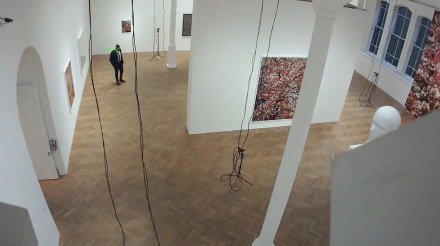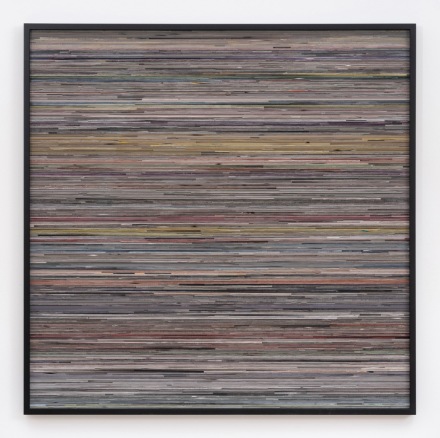
Trevor Paglen, Octopus (2020), via Pace
Taking over the Pace Gallery space at 6 Burlington Gardens in London, artist Trevor Paglen opens a show that seeks to find a shared physical and digital space, mining the artist’s long engagement with technology and aesthetics to present a set of new works that explore the society-shaping power of computing, and the massive troves of data collected every day online. His new show, Bloom explores central themes of artificial intelligence, the politics of images, facial recognition technologies, and alternative futures, marking his second show with the gallery.

Trevor Paglen, Bloom (#5f5554) (2020), via Pace
Paglen’s complex and pioneering work examines the systems and technologies that shape society. Employing a variety of disciplines throughout his oeuvre, from journalism to research, his show here moves between drawing and photography, livestreaming technology and digital components to explore the use of machine learning, and the historical precedents that often complicate and confound an easy reading of its context in the modern day. The works in the exhibition reference the “Vanitas” tradition in art, where objects such as skulls, flowers and books remind us of mortality, the fragility of life, and the vanity of worldly pleasures, here transposed through digital photography and sculpture to examine how the perception of form and meaning have been transcoded directly into the genes of modern capitalism and politics.

Trevor Paglen, Octopus (2020), via Pace
Paglen’s new interactive live-stream work Octopus (2020) responds to the current moment where periods of isolation, distance, and limitations impact how we experience work, while also extending the possibilities for shows into the digital sphere. The work presents the exhibition as an online portal, allowing visitors to see the gallery from the viewpoint of cameras trained on various angles of the artworks and the gallery itself. From close-ups of individual artworks at unexpected angles to wide frames of the room that allow online participants to watch visitors seeing the work in person, the view of the exhibition via webcam offers an uncanny experience between observation and surveillance, tracing movements through space and viewing both works and visitors in a panoptical experience of the gallery. Paglen’s new work offers a new perspective on virtual engagement in the gallery space, exploring both the attempts to extend and expand the footprint of online work . Embedded in the work is a critical dialogue on the nature of how we use media and technology and how it impacts the way we see and are seen.

Trevor Paglen, Classifications of Gait (2020), via Pace
Taking a central place in the show is The Standard Head, a large-scale reconstruction of the 1960’s mathematical model of a “standard head” by the pioneering researcher funded by the CIA, Woody Bledsoe. Conceived from the average measurements of the faces Bledsoe experimented with, Paglen reconstructed the “standard head” from rare information left behind in Bledsoe’s archives at the University of Texas. Artificial intelligence algorithms are designed and trained to look for faces, unique key points, lines, circles, and areas of interest as they attempt to deconstruct the underlying reality into a more simplified series of sections or shapes. The work emphasizes both a contemplation of profiling technologies, and the discriminatory underpinnings of cultural and biological analytics.

Trevor Paglen, Bloom (#79655d) (2020), via Pace
By contrast, the show’s titular series, Bloom, presents a series of large-scale photographs that depict flower formations conceptualized by various computer vision algorithms created to analyze the constituent parts of real-life photographs. The colors and shapes in the images represent similar areas that the AI has detected in learning from other images of flowers. They do not represent real-to-life colors so much as what the AI thinks the different parts of the images are.
Tracing such a broad range of conceptual material, Paglen’s show at Pace draws on the state of the world, viewed so often through a computer screen, and seeks to turn it both further outwards, and further inwards. The show closes November 10th.
– D. Creahan
Read more:
Trevor Paglen: Bloom [Exhibition Site]



